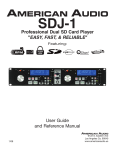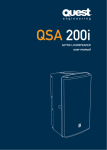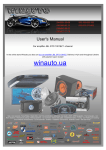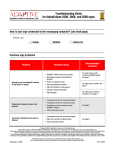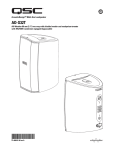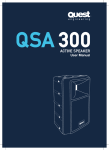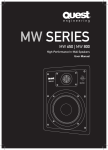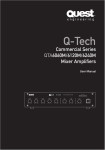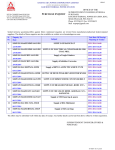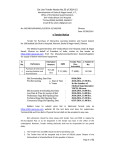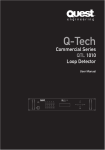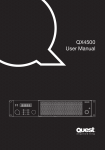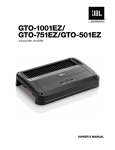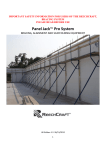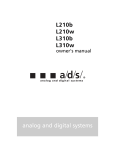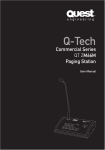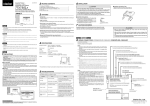Download MS Series User Manual
Transcript
MS SERIES MS 401 | MS 601 | MS 801 MS 401W | MS 601W | MS 801W All-Weather Loudspeaker System User Manual MS 401 | MS 601 | MS 801 MS 401W | MS 601W | MS 801W User Manual MS 401 | MS 601 | MS 801 MS 401W | MS 601W | MS 801W User Manual Safety Precautions Safety P.03 Installation P.04 Mounting the Speakers P.05 Connection P.06 Operating Tips P.07 Troubleshooting P.08 Specifications P.09 Flying and installation of this speaker cabinet must be carried out by suitably qualified personnel following the locally authorised and approved safety standards. Installation that allows direct precipitation is not advised and installation practise must prevent liquids from entering the box. Do not attempt to clean the plastic enclosure with solvents or petrochemical based cleaners. Do not stack the speaker cabinet in a manner that could cause injury should a cabinet become dislodged. Do not place sources of heat on the speaker cabinet such as lighting equipment or smoke machines, and where possible please keep out of direct sunlight. Attention Register Your Product Before connecting or operating your new Quest Engineering speaker, please study the accompanying instruction manual paying particular attention to the operating precautions and wiring procedure. Thank you for choosing Quest. Please take the time to complete your procuct registration card which is included with the packaging. Registering your Quest Engineering product will: SAFETY CONTENTS Contents 3 • CONFIRM YOUR WARRANTY Quest Engineering will not assume responsibility for incorrect installation or operation of this product. • REGISTER YOUR PRODUCT • PROTECT YOUR NEW PRODUCT User Manual MS Series All-Weather Loudspeaker System MS Series All-Weather Loudspeaker System User Manual MS 401 | MS 601 | MS 801 MS 401W | MS 601W | MS 801W User Manual MS 401 | MS 601 | MS 801 MS 401W | MS 601W | MS 801W User Manual 4 The MS Series all-weather loudspeakers are the ideal choice for supplying high fidelity sound in outdoor or marine applications. Their advanced polymer housing is designed to be acoustically inert and capable of surviving in harsh environments. The MS Series will stand up to moderate amounts of moisture, however, they should not be mounted where they will be directly exposed to heavy rain or water splash. In colder climates, bringing your loudspeakers inside for the winter, when they are not being used, is advised. Mounting hardware and grills are aluminium, to drastically reduce corrosion. The vented cabinet design and high-compliance woofers generate realistic bass response in open air applications and the high-efficiency soft dome tweeters yield extended high-frequency response. Note: The vent openings on the front baffle of the loudspeakers should always be pointed down, or away from any potential source of water or other liquid, in order to avoid having moisture enter the cabinet. Failure to observe this precaution could lead to premature failure of the loudspeaker. Installation Installing the MS Series, All-Weather Loudspeaker System is not difficult. However, correct wiring and proper placement play a vital role in optimising sound quality. This manual provides information on the placement, connection and operation of your loudspeakers. Please read it thoroughly and save it for future reference. Speaker Placement Where speakers are placed significantly affects their sound. Some general placement guidelines are as follows. However, since all situations are different, you should experiment with various locations to determine where they ultimately sound best. Outdoor Use Although the MS Series loudspeakers are ‘allweather’, when using them outdoors you will extend their life and improve reliability if you avoid mounting them where they will be exposed to direct sunlight for extended periods of time. User Manual Mounting the Speakers MS Series All-Weather Loudspeaker System Boundaries In general, the MS Series loudspeakers will produce the smoothest response and best stereo image when located at least two feet from any mounting environment boundaries, such as the ground or floor, ceilings or walls. Moving the speaker closer to one or more boundaries will increase the bass output. In some installations, the extra bass will enhance the sound which may be desirable depending on the application. “Hard” surfaces near a speaker can affect the distribution of high frequency sound in the listening area, as a result, the accuracy of the stereo image may be impacted. If the speakers are near the corners, point the speakers toward the centre of the listening area. Experimenting with speaker placement before final mounting is the most important thing you can do to achieve the best possible sound. Before mounting the speakers in brackets, plan the mounting location and method very carefully. Follow the speaker placement guidelines, as described on the preceding page of this manual, and decide on the mounting locations. If you plan to hide the speaker wires behind the mounting surface, route the wires before you mount the brackets. See the following section for information on wiring. The suggested method for attaching the brackets to the mounting surface depends on the structure and material of the mounting surface. There are two typical situations. One is with the brackets attached to a conventional wall constructed with masonry material or dry wall over wood studs. The other situation is with the brackets mounted to a wood structure or some other solid material. When the speakers are mounted on masonry walls or dry wall, use plastic screw anchors to strengthen the attachment to the wall. When the speakers are mounted to a solid panel the screw anchors will not be required. (a) Set the bracket in the desired installation location. Be sure it is straight. (b) Using the bracket as a template, mark the location of the two mounting screw holes. Set the bracket aside. (c) If plastic anchors will be used, drill the appropriate holes for them. If only self-tapping screws are used, drill pilot holes with an 1/8" bit. (d) Push the plastic screw anchors, if they are being used, into the holes drilled for them. Drive the mounting screws through the bracket, into the holes, until they are firmly set. (e) Connect the wire to the speaker, observing the correct polarity (refer to next section). Set the speaker in the mounting bracket and secure it by inserting the provided threaded knob, tightening it once the speaker is rotated to point in the desired direction. INSTALLATION INSTALLATION Description 5 Speaker Placement Stereo imaging is generally best when a speaker’s long axis is vertical, but horizontal placement is by no means ruled out. Try the speakers both ways to determine if the difference in sound is important to you. MS Series All-Weather Loudspeaker System User Manual Making the Connections Speaker Protection Please use two-conductor stranded-type, insulated wire to connect to the amplifier. “Lamp” wire or “Zip Cord” are suitable. If running wiring within the walls, make sure it complies with your local building codes pertaining to low-voltage wiring. Use at least 19 gauge for runs of less than 50 feet. Use 14 gauge or larger wire for longer runs. The resistance of 18 gauge or smaller wire can cause a bass response peak if used for more than a few feet. Connect the positive conductor of one wire to the red input connector of one speaker and to the red, or “+” speaker output connector of the associated amplifier channel. Connect the negative conductor of the wire to the black terminal of the speaker to the black, or “-” connector of the associated amplifier channel. Repeat the procedure for the other channel. Be sure to follow exactly the same connection procedure for both channels. The MS Series speakers have a solid-state, fully automatic tweeter protector. This reduces the power to the tweeter when the speaker is operated at unsafe power levels. The protector resets itself when power is reduced to a safe operating level. If high power operation causes the tweeter to stop playing, please turn down the volume control until normal sound resumes. Preparing the Wire Input Selector Switch 2Ω W 0Ω 8 ohm W W 10 3 W 20W 49 16 3Ω 2 4 5Ω 0Ω 2 DIRECT Note: The tweeter protector provides a significant level of protection, however, it is no guarantee that a tweeter cannot be damaged. Please take care when operating the speakers at a high volume level. Maintenance The MS Series drivers require no routine maintenance. Do not let anything touch the drivers. Do not vacuum clean the drivers or front panels of the speakers. Some dust accumulation on the drivers is normal and does not affect the sound in any way. Heavy dirt buildup may be carefully removed with a soft paintbrush, if required. The enclosure of your MS Series speakers require no maintenance, other than regular dusting. Dust the speakers with a dry, or slightly damp cloth. To clean the grills, remove them from the speaker and vacuum them. Do not vacuum the grille while they are on the speakers. 7 Protect Your Hearing 100 V LINE DIRECT 8 ohm W 20 4 W 30W 24 12 2Ω 1 6 3Ω 5Ω 1Ω W 0 MS Series All-Weather Loudspeaker System 100 V LINE 0 User Manual 5 W 0 5Ω 2 W 1 5 W 1 9 4 24 5Ω 3 6 5Ω 9 The MS Series speakers have colour-coded push-to-connect input terminals that accept virtually all types of speaker wire. Push the back of the terminal to open the wire access hole. Put the stripped wire, or pin terminal, into the hole and release the terminal. 8 ohm 60 Speaker Input Connectors 9 1 The polarity – the positive/negative orientation of the connections– for every speaker-to-wire and wire-to-amplifier connection must be the same, so the speakers will be “in phase”. If the polarity of one connection is reversed, bass output is reduced and stereo imaging is degraded. All wire is marked as to identify the two conductors. There may be ribs or a stripe on the insulation of on conductor. The wire may have clear insulation with different colour conductors (copper and silver). Decide which conductor you will use for “positive” and which for “negative”. Then be consistent with every speaker-to-wire and wireto-amplifier connection. DIRECT 40 Polarity 100 V LINE 1 Estimate the amount of wire needed. Allowing enough extra wire to move the speakers if necessary. Separate the conductors of each wire pair a few inches in from the end. Strip about 3/8" insulation from each conductor - careful not to cut into the wire itself. Twist the strands of the conductor together to avoid fraying. For outdoor use, Quest recommend terminating the wire with gold-plated pin-type terminals and insulating the wire-to-pin connection with silicone filled heatshrink tubing. Bare copper wire can corrode and cause unreliable connection over time. OPERATING TIPS Wire 2 6 MS 401 | MS 601 | MS 801 MS 401W | MS 601W | MS 801W User Manual 0 CONNECTION MS 401 | MS 601 | MS 801 MS 401W | MS 601W | MS 801W User Manual All speakers, including the Quest MS Series, with extended periods of use can damage hearing beyond repair. Quest Engineering suggest care when using any sound equipment over long periods. ATTENTION: Make sure the input slector switch has been set to the correct location. For normal, low impedence operation ensure the input selector switch is set to 8Ω. For line voltage settings, ensure that the number of speaker units, multiplied by the power setting, does not exceed the amplifier power. Doing so will result in extreme damage to amplifiers. MS Series All-Weather Loudspeaker System User Manual 8 Most difficulties with high fidelity equipment result from loose or poor connections, bad connecting cables, or switches in the wrong positions. No Sound Ensure the Input Selector Switch is set to the correct position. It is rare for a speaker to fail completely. When there is no sound, check all the speaker wire connections and the setting of the amplifier’s tape monitor or speaker selector switch. Dull or Muted Sound Operating the speakers at unsafe power level activates the automatic tweeter protector. Turn down the amplifier volume control and the protector will automatically restore signal to the tweeter. Also check the amplifier’s tone controls or “high filter” switch. Distorted Sound Distortion at moderate levels can be caused by loose connections, or stray wire strands shorting out adjacent wires at the amplifier or speaker terminals. If you hear distortion, or any other type of buzzing or rattling sound from an individual driver, contact your Quest Engineering dealer. Distortion at high levels is the result of either reaching the power limit of the amplifier or of the speaker. Turn down the volume to prevent damage. Noise or Hum Continuous background noise or hum are always from the electronic equipment and not from the speakers. General Troubleshooting Tips Buzzes and Noise in the Sound System: Getting rid of unwanted noises is a study in itself. Most of the noise, (apart from undesir-able program) will fall into three categories. (A) White noise. This is the hiss that suggests that the gain structure is set incorrectly. Something in the signal chain is boosting too much or an input is set too sensitive. If your equipment has gain User Manual MS Series All-Weather Loudspeaker System MS 401 | MS 601 | MS 801 MS 401W | MS 601W | MS 801W User Manual switches on it, set them all the same. If the switch is labelled +4dB, set them all to that figure. If one piece of equipment seems to be overloading, set them all to -10/-20dB and be prepared to boost the input level. The last unit in the chain should be set to +4 dB at the output stage if possible when connected to the line level input. Quest Engineering MS Series Specifications MS 401 / 401W Specifications Peak Power 100W Power Handling 50W (B) Low frequency hum. This is often caused by noise from the power leads being picked up by the audio signal cables. The preferred solution is to connect up your system with “balanced” XLR microphone cables. Especially if you are running the cables a long distance, (more than 5Mtrs /15 Ft). The other solution is to make sure that your audio cables are as far from power cables as possible. Type Bass Reflex Impedance Nominal 8Ω Transformer Tappings 25W / 20W / 15W / 10W + 8Ω Direct (C) Buzz. Sometimes you can experience a hum and buzz together. A buzz is almost always a problem with the “earthing” of the system. It will often occur when you have the system powered from sperate power outlets in the same building or audio and lighting sharing a common power circuit. Even when the audio and lighting systems are powered from separate sources, there can still be a common earth between them. For example, a smoke machine may be powered from the lighting system, yet the trigger mechanism could be connected to the audio system through the audio multi-core/snake. An earth connection between the audio and lighting will now exist and a buzz could be amplified in the audio system. The simple solution is to power your audio circuit and everything con-nected to it from the same source. If the buzz persists, check your signal cables, one may have an earth/shield disconnected. A cheap but possibly life saving investment is a domestic power tester to check that the power supply sockets are correctly wired. Faulty or incorrectly wired power is a booby trap more common than you think. Components LF 4" Poly Propelyne Cone, Rubber Surround, 25 mm Voice Coil HF Dome Tweeter PEI Diaphragm, 20 mm Voice Coil Angle of coverage 90˚ x 90˚ Sensitivity 1W @ 1 meter 88 dB Max SPL 108 dB Frequency Response 80Hz-20Khz ±4dB Crossover Frequency 3000Hz Crossover 12 dB Enclosure Material UV Stabilised ABS Bracket Material Aluminium Grill Material Aluminium Dimensions 153 mm x 180.5 mm x 278 mm Weight 2.6 kg Shipping Dimensions 203 mm x 226 mm x 319 mm Shipping Weight 3.3 kg SPECIFICATIONS TROUBLESHOOTING MS 401 | MS 601 | MS 801 MS 401W | MS 601W | MS 801W User Manual 9 All specifications are correct at time of printing, Quest Engineering reserves the right to change specifications at any time and won’t be held responsible for any typographic errors in this publication. It is wise to avoid switching on or off devices in the signal path while the speaker system is powered and turned up. Otherwise loud clicks and bangs could result. When shutting down the system, always turn the speakers off first. This is to prevent the speaker amplifying the sound of the other equipment in the chain being shut down. The reverse is true when powering up. Mixers and effects on first, power amplifiers or powered speakers on last. MS Series All-Weather Loudspeaker System User Manual 10 Quest Engineering MS Series Specifications Quest Engineering MS Series Specifications MS 601 / 601W Specifications MS 801 / 801W Specifications Peak Power 160W Peak Power 240W Power Handling 80W Power Handling 120W Type Bass Reflex Type Bass Reflex Impedance Nominal 8Ω Impedance Nominal 8Ω Transformer Tappings 40W / 30W / 20W / 10W + 8Ω Direct Transformer Tappings 60W / 40W / 30W / 20W + 8Ω Direct Components Components LF 6.5" Poly Propelyne Cone, Rubber Surround, 35 mm Voice Coil LF 8" Mica and PP Cone, Rubber Surround, 35 mm Voice Coil HF Dome Tweeter, Silk Membrane, 25mm Voice Coil HF Dome Tweeter, Silk Membrane, 25mm Voice Coil Angle of coverage 90˚ x 90˚ Angle of coverage 90˚ x 90˚ Sensitivity 1W @ 1 meter 90 dB Sensitivity 1W @ 1 meter 91 dB Max SPL 110 dB Max SPL 114 dB Frequency Response 60Hz-20Khz ±3 dB Frequency Response 55Hz-20Khz ±4 dB Crossover Frequency 3000Hz Crossover Frequency 3000Hz Crossover 12 dB Crossover 12 dB Enclosure Material UV Stabilised ABS Enclosure Material UV Stabilised ABS Bracket Material Aluminium Bracket Material Aluminium Grill Material Aluminium Grill Material Aluminium Dimensions 195 mm x 214 mm x 335 mm Dimensions 259 mm x 290 mm x 445 mm Weight 4.35 kg Weight 5.75 kg Shipping Dimensions 247 mm x 287 mm x 377 mm Shipping Dimensions 320 mm x 360 mm x 487 mm Shipping Weight 5.5 kg Shipping Weight 7 kg All specifications are correct at time of printing, Quest Engineering reserves the right to change specifications at any time and won’t be held responsible for any typographic errors in this publication. User Manual MS 401 | MS 601 | MS 801 MS 401W | MS 601W | MS 801W User Manual MS Series All-Weather Loudspeaker System SPECIFICATIONS SPECIFICATIONS MS 401 | MS 601 | MS 801 MS 401W | MS 601W | MS 801W User Manual 11 All specifications are correct at time of printing, Quest Engineering reserves the right to change specifications at any time and won’t be held responsible for any typographic errors in this publication. MS Series All-Weather Loudspeaker System User Manual www.questaudio.net







